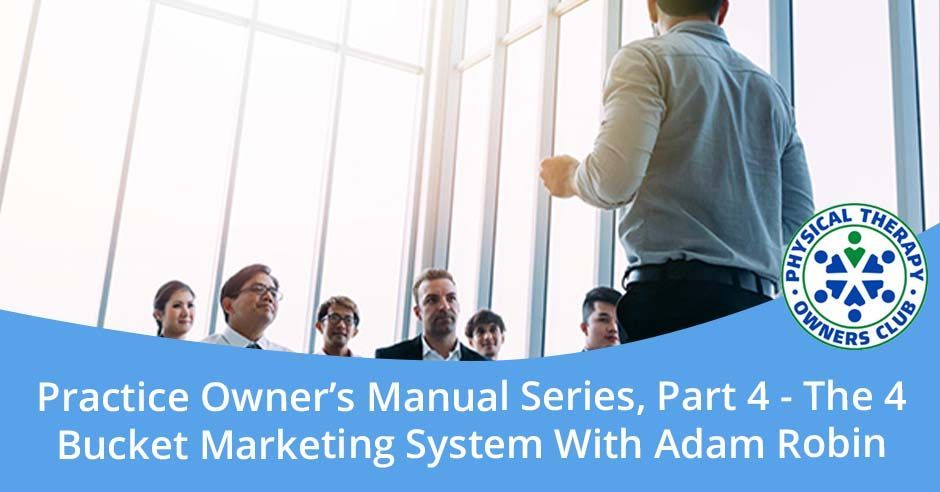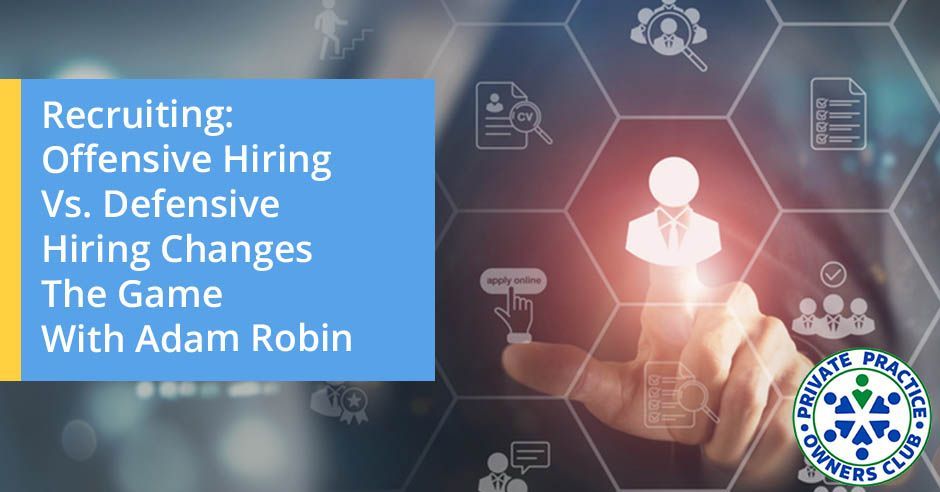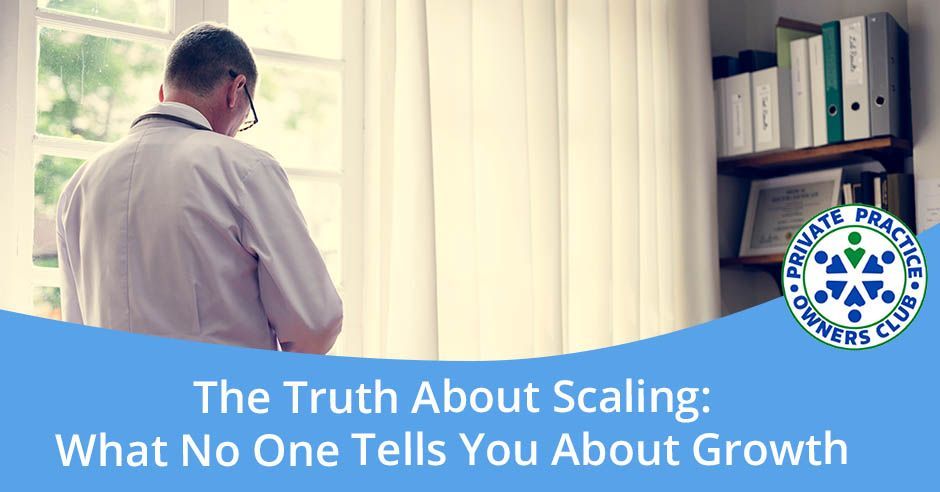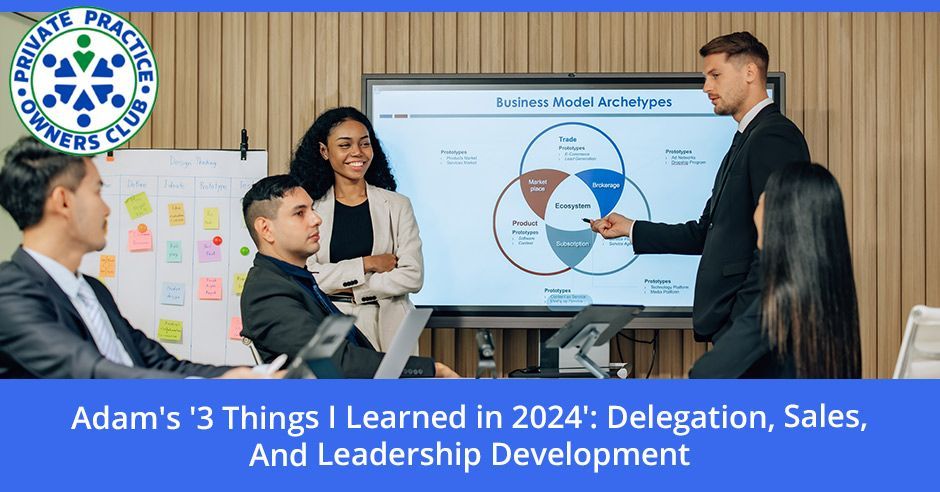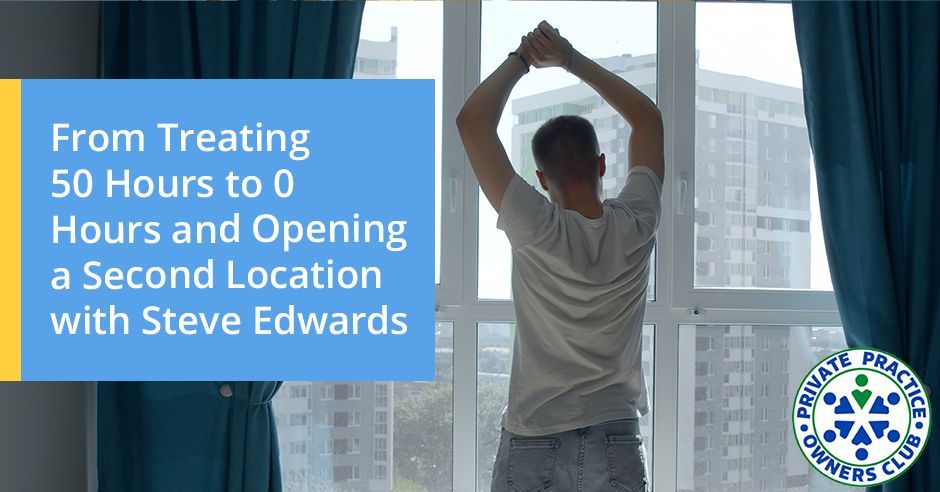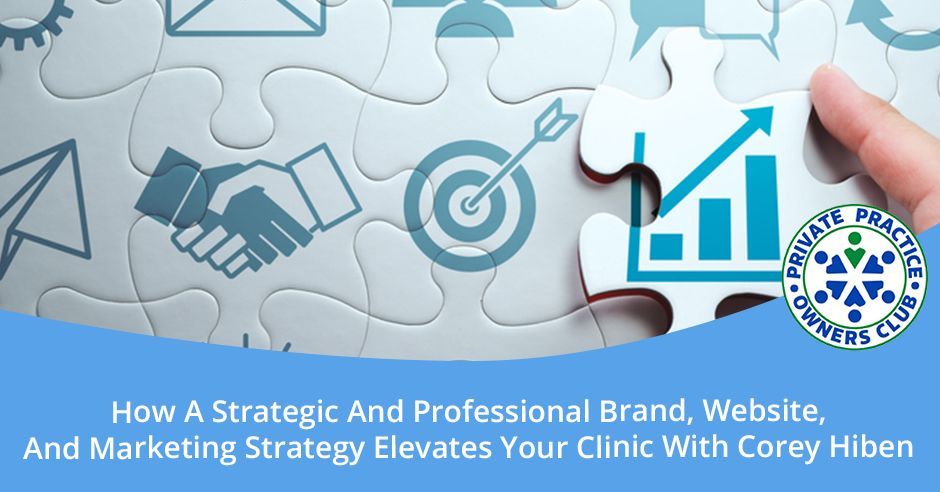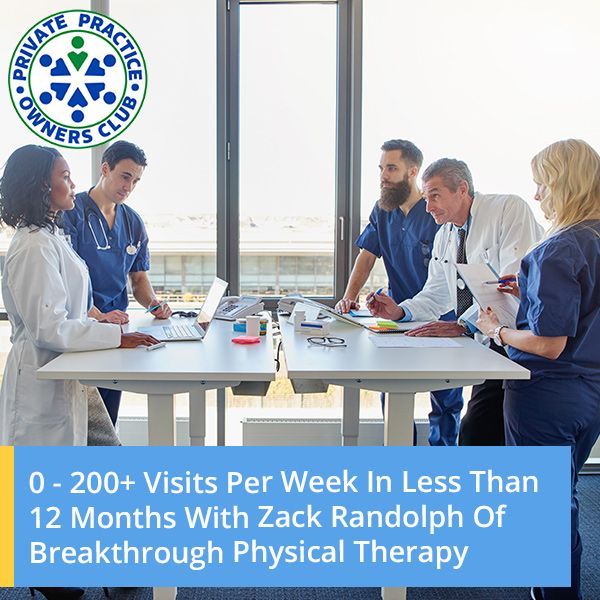In this episode of the Private Practice Owners Club Podcast, Nathan and Adam delve into the four essential marketing buckets crucial for every private practice clinic owner's success. Discover how to establish a strong marketing plan that can elevate your clinic from a standard practice to a flourishing business.
They discuss simple, cost-effective methods for generating referrals from your current patients, as well as strategies for reactivating former patients and maintaining their engagement. Learn how to cultivate and nurture strong relationships with referring physicians to ensure a consistent flow of referrals. Additionally, explore innovative ways to connect with your community through social media, events, and more.
Nathan and Adam offer practical advice and real-life examples, including a story about how a PTA converted patient referrals into a steady stream of new business.
Are you prepared to take your practice to the next level and uncover the keys to successful marketing? Don't miss this thrilling episode with Nathan Shields and Adam Robin as they explore the world of Marketing Systems.
Want to talk about how we can help you with your Private Practice business, or have a question you want to ask? Book a call with Adam -
https://calendly.com/adamrobin/dr-adam-s-30-minute-connection
---
Listen to the podcast here
Practice Owner’s Manual Series, Part 4 - The 4 Bucket Marketing System With Adam Robin
I got my partner
Adam Robin with me. How are you doing?
I’m fired up per usual. How about you?
Intro
I'm doing well. I’m excited to get into part four of The Practice Manual Series, how any provider can lay the foundations for a successful practice. We're moving forward into part four, which is our marketing systems. We're talking about the four buckets. Before we get into it, I want to give credit because I think my interpretation of the four buckets of marketing stemmed from a previous episode with Steve Line who wrote
The Feel-Good Experience. He talked about the four buckets and I've essentially stolen this idea from him, but he puts it succinctly and nicely.
He also wrote an article about it in Impact Magazine a number of years ago, but it makes it easy to generate a real marketing program when you put your marketing into four buckets and know what you want to pay attention to. Doing this can make you like a legitimate business that has a marketing plan. Heaven forbid, we are physical therapists with marketing plans.
You better watch your mouth. You get thrown in jail for that around here.
It is typical, that the physical therapist personality is, “I don't want to be salesy. I don't want to do sales,” but we're trying to do sales all the time. We should be promoting the good things that we do in physical therapy and how we are the MSKUs experts in the healthcare field. There's no one better. Maybe the orthopedic surgeons might have a leg up on us in some regards, but not totally. We need to do better at marketing in general.
Not only that but building a culture of promotion. First, it starts with you and then how do you build a team where everybody is a promoter and marketer and believes. Here's the thing. If you've been in business for a short period of time, then you're probably been fooled into thinking that you need to have this robust, super-secret marketing system that's going to cost $100 million. It's got to have to have Facebook ads and all this tech. Not really. If you can pick out a few things and be consistent with them, you can outperform 98% of people because most people ain't doing nothing. That was my Southern twain coming out.
If you can pick out a few things and be consistent with them, you can outperform 98% of people because most people aren't doing anything.
The therapists that understand this well, because they have to, are those that are the cash-based practices where they're not taking insurance at all. They have to be selling and promoting on every visit. These guys and girls are selling ten-visit packages. They're selling, “We're going to get your shoulder better. It's going to cost you $2,500 and ten visits.” They're selling them all up front and it forces them.
I think if we had a little bit more of that in each of us not just the owners, but as providers as a whole, we get better retention, we get better results. We'd not let the patient's financial abilities affect our plans of care and it shouldn't. They'd come more often. I think it'd be a benefit for everybody, but this forces us. Nonetheless, you've started these episodes by telling everybody, “Get out your paper, get out your pen, and here we go. Here's the next stage.”
Write it down. Chapter 4, Marketing. On a blank piece of paper, you're going to write the word marketing at the top. It's going to be called a marketing plan, and then we'll go through four buckets.
We're going to talk about the four buckets. We always use the word avatar and it might be overused, overplayed, you name it. Can we talk about the avatar first? Do you think that's an appropriate place to start?
Absolutely.
As we're looking at our marketing, it's imperative to know, “Who am I talking to? What am I trying to say? What do I want them to know and feel? What do they want to hear to buy my product?” A great example of this was
Angie McGilvrey. I did an episode with her a number of years ago. She and her husband were in Florida, and they experienced a hurricane. They shut down their clinic. It destroyed the building.
They had to rebuild from scratch. Before the hurricane, they were accepting of all comers. They were mostly Medicare. They had a good practice. Just your typical outpatient orthopedic practice that took all comers. When they had the opportunity to start from scratch and build it up again, they decided, “Let's build a clinic that we want and see the patients that we want to see.” They decided to figure out their avatar to speak to this point. They decided, “We want to work with CrossFit female athletes in their 30s. That's our target market, and we're going to target them and only them. All of our material and clinic setup is going to be geared towards those athletes.”
We are ten years down the road now, and they see those athletes. They see other athletes and more, but now it's so fulfilling. They're seeing the patients that they want to see. They're getting revenues and profits that they weren't getting before. People are finding them through methods that they hadn't considered before or hadn't used before because now that they know their avatar, they know where those avatar watering holes are. They know how to go to them.
These 30-year-old CrossFit athletes are going to be on such and such social media apps. We're going to put our marketing there. They want to see things in the gym. They put up CrossFit-like structures. They put racks up in their gym. They introduced ultrasound, dry needling, suction, and all that stuff, which athletes would expect. Knowing your avatar can go a long way, telling you and guiding you on where you're going to spend your money, time, and energy when it comes to your marketing plan.
One of my favorite lines is, “People don't remember what you do. They remember how you make them feel.” If you don't know who you're talking to, you can't help facilitate the emotional response that you're looking for. Female CrossFit athletes, I didn't prepare this. I'm thinking outside the box a little bit. What are some of the things they'd be interested in? They're probably image-conscious. They probably want to look fit or feel fit. They probably want to feel confident. Maybe they have a little insecurity about the way they feel or look. Maybe they want to be able to compete in a CrossFit competition. Maybe that's important to them.
People don't remember what you do. They remember how you make them feel. If you don't know who you're talking to, you can't help facilitate the emotional response that you're looking for.
What would be scary to them? The thing that would be scary to them would be an injury that would impact their ability to do that, that would strip their identity away from them. What we're talking about here is there are very specific pain points and emotional challenges that they're having. We want to make sure that our marketing message is consistent with that. “CrossFit athlete, are you somebody who values looking amazing in the mirror and competing at a high level? We would love to talk with you.” That's the power of having that avatar. You can start putting language towards the things that are important to them.
You can also set up your team for that particular individual. You can imagine a CrossFit athlete who is expecting a certain language. When I say WOD, does everyone in the clinic know what a WOD is? That’s Workout Of the Day. That's common CrossFit vernacular. If you said wad and people looked at you quizzically and you're a CrossFit athlete, they might be like, “Maybe this isn't the place for me.” You want to have that understanding with your team and your setup. You would want to see these types of people at your CrossFit events. That's another marketing point. That's one way.
At the top of your paper, you're going to want to write out your avatar. Your avatar is your ideal client, and everything specific about them, how old they are, their gender, their profession, their family status, how much money they make, what they're dealing with in their everyday life, and how they're feeling. That is your avatar so that you know what the message is going to be and where you're going to spend most of your time and money. Your time, money, and energy are going to be spent in their world.
What are their dreams? What are their ambitions? What are their fears? What are their insecurities? How do they like to consume information? Where do they shop? Where do they hang out?
What are their pain points? What are they going to make a healthcare-based decision on?
That's good information. The more information you can get on the people you're trying to serve, the more that you can serve them.
Give them a name if you want to.
The first thing on the paper is, “Our ideal client is,” then write it down. Share it with your marketing team and your clinical team. Define it, describe it. Who is it? What do they want to get back to doing? What are the things they want? Get inside the head of that person. Understand them. It can help you build something useful on the marketing team.
Anything else you want to add after Avatar on a piece of paper before we get into the four buckets?
Marketing in general, there's this theory. I won't spend a whole lot of time on it, but it comes down to getting the reps in. You have to get the reps in. You have to have a quantity of repetitions of phone calls, text messages, and emails. The repetitions count. There's quantity and there's quality. If you can have quality and quantity with consistency, then you can have a good marketing plan.
When we're talking about these buckets, try to write down next to each bucket, what is the quantity? What do I need to produce? What's the input that I need to put into this bucket? How do I make it good? How do I create some quality behind it, and then how do I build a habit of consistency through it? I want to send a good email, 500 a week all the time, weekly. How do I make that happen without it occupying a lot of my brain? I want to try to create that on autopilot. If you can create that in each of those buckets, then you have a marketing plan.
What owners tend to experience if they're like me and a newer owner is referrals come in, I get ramped up, I get busy, I disregard the marketing especially because I don't want to do it, then it falls off and numbers go down. I have to ramp up marketing efforts again, and then I get busy again, and then I stop doing marketing and numbers go down. You go through this rollercoaster over and over, whereas the consistency allows you to build that foundation and continue building off of it. It's more of a linear increase instead of a rollercoaster.
That's what we're trying to encourage people to do, especially if they're looking for growth and expansion. Get some consistent growth year over year and not just hovering between 0% and 10% growth levels every year. A lot of it has to do with consistency and putting in a consistent amount of effort. The four buckets that you can put across your page or one after the other are current patients, past patients, referring physicians, and I call the fourth one, community. I don't know what you call it, but it's outreach to the community, which would include social media, SEO, web page stuff, events that you attend, speaking engagements that you do, sponsoring leagues, and that kind of stuff. Did I cover the four?
That's the four.
Current Patients
Let's get into the first one, current patients. What would you tell people about current patients?
It is the easiest, the cheapest, and the most bang for your buck. Start there every time. They're already in your clinic. They already know, like, and trust you. They're already giving you money. All you have to do is have a conversation with them. Create a system in which you deliver care. It's like, “How do I take a look at the life cycle of the patient inside my practice?” They come in and check in. You do an eval, they do a follow-up, you do a progress note, and you do a discharge. You email them after the discharge, and then you call them about 90 days later, and it keeps going around and around.
You re-activate them and get back into the clinic. Now that I understand that life cycle, how do I operationalize some consistency, some quantity, and some quality in that so that I can generate patience inside that life cycle? That can be a series of emails. Maybe it's like, “I hope you're having a great experience over here. I would love a referral. Would you mind sending us a referral?”
It could be a conversation that you're having at a certain checkpoint. Maybe it's a progress note at the discharge. It's like, “It's been amazing to work with you. I'd love an opportunity to treat anybody and your friends or family members. Do you know anybody?” You want to operationalize that and train your team on how to help you do that. You're going to create the lifecycle, operationalize it, and then get your team involved in a weekly team meeting and start talking about ways that you can leverage your current patients to generate more referrals.
This is where we decided to put some added effort and it bore some fruit for sure, and that is to take our patients to their best points during therapy. What I mean by that is when they come in and they're happy, they're effusive about the progress that they've made. That's the flashpoint. That's when you want to take advantage of this opportunity. We did this by training our team.
When I say training our team, it was role-playing with our team, whether it was the techs, the PTAs, the front desk, the providers, you name it. Anyone could do this at any time if someone was positive about their experience in the physical therapy space that we had, and that was, “It's amazing that you're doing well. Do you know anyone else who's in pain?” I don't know who wouldn't say yes. Most people should unless they're twelve-year-old athletes.
If you know any human beings, you probably know 1 or 2 with back pain.
That starts the conversation. “I know so and so sprained their ankle. Do you guys work on ankles?” “Yes, we work on ankles. This is what we do and this is how you could help.” We had a reward system at the time where if they sent a referral and they came in the clinic, they got some gift, whether it was movie tickets or something like that, something we set up. We had referral cards as well. Business cards that were made as referral cards. Give this to a friend that you think could use some help, and put your name on it. If they turn it in or you turn it in, they qualify for the reward.
That was one thing we leveraged. I've shared this before. One of our PTAs we tried to ask to help with marketing to physicians would nearly cry every time because she would be nervous about talking to a physician. She was our best at getting referrals from patients. She would ask for patients. If we had a contest about procuring the most patient referrals at any given time, she would inevitably win. Not only did we set a reward system for the patients if they referred somebody, but if the team member procured that as well, they got a $20 gas card. She would go quarters at a time without having paid for gas. She had gas cards all the time because of the referrals that she generated through our programs.
It's a powerful thing if you can envision that on your paper. Now, you have a life cycle. You've started to envision ways you can operationalize these touchpoints to create these conversations organically and then get your team involved. When you can do that well, you can generate referrals. What I've seen from owners who don't do this well, we have the mindset of, “I don't want to be creepy. I don't want to ask patients for referrals because that would be self self-promoting and I don't want to do that.” That's the mindset hurdle that we have to get over. What I would challenge you to do is start thinking about 1) Do you believe in what you do? Do you truly believe that you can help people? If you do, then you should try to help people.
Do you really believe in what you do? Do you truly believe that you can help people? If you do, then you should try to help people as many people as possible.
As many people as possible.
If you believe in it, do it. If you don't believe in it, then maybe you shouldn't be doing this. Do you believe in yourself? Let's tell people we believe in it, and then 2) Ask them for what you want. It's like, “I believe in physical therapy. I love helping people. I could use your help with that. Would you be willing to help me?” It’s very simple. You have to move through that discomfort. You have to get over that mindset block. I promise you on the other side of that are a lot of possibilities where patients will be totally happy to help you.
Past Patients
Our purpose as physical therapists is to help people. The more we can do that, the better physical therapists we are. If you're a good therapist, then you're going to hide in the corner and not tell anybody what you are as a physical therapist. We should be finding as many people as we can. Interestingly, that same PTA, now when she saw people at a grocery store with a sling on, out of rotator cuff surgery, she'd approach them like, “How are you doing? Are you feeling all right? Are you getting good therapy? What are your plans?” That's someone who understands their purpose as a physical therapist, as a provider in the healthcare space to help as many people as possible. She bought into that. It was good. The second thing, reactivating patients is an extension of that.
Past patients.
Not only can you get them to reactivate and come back in, but you can still play the “You're doing better. You don't know. You're doing fine. You don't have any issues right now. You've overcome your problem. Are you sure your back is doing all right and your shoulder is doing okay? We don't need to address a different issue. Do you know anyone else who is in pain?”
I keep harping on this PTA because she's a great example of this. She took it to the next level so that when she had some free time, maybe a patient got canceled, she'd be doing follow-up calls, 90, 120 days later, 6 months down the road, and say, “How are you doing? I wanted to follow up on you.” She would ask, “Do you know anyone else who is in pain? How can we help them?” It’s a great opportunity to infuse both of those projects or energies into one.
It's about creating the system. You have to create some policy around this. You should have an EMR and you should be collecting names, phone numbers, and emails from every single patient that comes into your practice. It should be a policy that you cannot be a patient unless you give me your email. You do not accept patients without emails. “Here, give me your email.” You have a list of patients. You might have 5,000 names. Reach out to them. Step 1) Go to the EMR. Look up all the patients who were discharged three months ago or last quarter. Create a list and post it on the wall in the clinic, or post it on Google Drive. You're going to call, email and you're going to text.
Make note of the conversation that it got done.
Make note of the conversation. It's like, “It's been a while. I hope your shoulder is doing great, but if it isn't, I'd love to help. How have you been?” Everybody is responsible for making a handful of calls each week and it's like, “Let's reach out and let's network.” I promise you you'll reactivate a handful of them, or you'll find a friend or family member, “My daughter is going to have a total hip next week. I'm glad you called. I'm going to go ahead and give her your card right now. Fantastic. Can I follow up on that?” There's a patient right there. Operationalize that, and you'll crush it.
You can imagine that your physician referral list, maybe you have 100 to 200 names on there on your physician referral list of people in your localized radius. Compare that with a list, especially if you're established for 5 or 6 years, the list of patients that you have are thousands of people long. The impact of that could be as equal if not more than that physician's list of referrers.
Leveraging that information for your benefit is huge. It's what all these companies like Google, etc., pay for. It is that information. In order to do sales, you should be doing the same thing with your EMR system, using that data for sales per se. It can be the 3 to 6-month reach-out period. It can also be, “Father's Day is coming up. We got this Father's Day special. Send your dad in for a free consult for 15 to 30 minutes,” and set aside a certain day or half a day for free consults based on the marketing plan.
This is when you start seeing a marketing plan to come together and how you use data. July 4th is down the road. What's something else you could do? One of our coaching clients was going through a lull and he decided to do a free day of consults the entire day. He sent out mailers, emails, and text messages, and posted them on his Facebook. He did that 2 or 3 times, which round of those, and booked out the whole day of free consults for the entire day.
It was an anniversary thing like, “We want to give back on our anniversary date.” They did that. He got more new patients than he could ever imagine. I think his goal was 30 new patients and he got 33 or 37 or something like that out of a free day of consults. That's the power that you can use when you leverage it.
Can we talk about mindset blocks here?
Please.
The two that I'm seeing. 1) Same one, “I don't want to call and bug them. I don't want to be creepy.” If you're having that, you might want to start thinking about, “Do I believe in what I'm doing? Am I really trying to help people?” You have to sell yourself on that first. If you're not sold that you're helping people, then you're going to have a hard time with it. The second thing is, “I don't have time for that. I'm too busy to pull out the patient list and all that stuff.” I would say you lack commitment towards it.
It's like you do have the time. You're just choosing to spend your time doing something different. You have to take a little chunk of time away every month. You have to train your team, implement this process, and make sure it's getting done. If you will, it will be a very valuable thing that you're doing. It's a good time to spend. Take out a couple of patients every month, block off your schedule, and spend the time doing this. You'll have a good ROI on it.
I'm someone who hates doing that stuff. I had to out of necessity. What I found was for your second roadblock mental hurdle, not doing it was me and I would set up my schedule such that I didn't have time to do it, but when I found someone who would do it, there's the ticket. Find someone interested in doing it. There are people out there who want to do this stuff. Find them, empower them, delegate them, and give them the KPIs and the expectations. Tell them the quantity, quality, and consistency that you want. Rev them up and let them go. They're going to pass any marketing materials past you first so you have the ultimate say because you are the CEO, but they can go out and do those things for you. It gets done on a consistent basis, which is exactly what you're looking for.
Physician Referrals
Let's talk about the next bucket.
Third bucket physician referrals.
We did a whole show on this. Old school stuff. Physicians have access to patients that they want to treat. They're good to know, but they're the third bucket. They're not there at the top, but you have to develop relationships. You're the CEO. Unfortunately, part of that job title or part of that role is developing, maintaining, and nurturing important relationships in the community
I wouldn't say unfortunately. It’s the benefit of being a CEO.
Maybe unfortunately to somebody who doesn't want to do this. You can't outsource this. You got to do it. You have to develop these relationships and you have to get on the level of the physician, not get from underneath them. See them eye to eye and be like, “We're partners in this. I'm here to support you like you're here to support me. Let's create a win-win. Let's support each other. This is what we're about. We want to help you. How can we do that?” Make sure that it's like, “Who are the physicians in your area?” Make a list of them. Maybe there's 10 or 150. You should know their name. You should know their phone number at least to their office. Maybe even you know their manager's name, the name of their business, and what type of patients they treat.
The referral coordinator.
It's like, “I'm going to commit to meeting two a month forever. I'm going to meet them and I'm going to have lunch with them every now.” You are intentional about creating that system like, “How do we grab that information?” We use Google. You can find that information. Do some outreach phone calls, do some faxing, go drop by some goodies, and set up some meetings. Doing that consistently maybe twice a month, you block off 3 or 4 hours and that's your marketing time. You're going to do your marketing. That's it. Develop some relationships with physicians.
It's fallen out of favor, and I can only see why it has in this regard. It is that many hospitals have taken over that relationship for the physicians. They brought them in-house. These physicians are constrained as to who they can refer out to. They can only send physical therapy patients over to hospital-based physical therapy clinics within their network. I can understand that, but there are still a number of general practitioners, orthopedic surgeons, and internal medicine doctors who probably are not within the hospital system. You should know them.
If you can get into the hospital system in some way, especially if you happen to see a patient that comes by who decides to come to you and not stay within that hospital network, maybe you can follow up with them by going with them to their follow-up visit. I've seen that a number of times with providers and patients. They'll go back to the workers' comp injury, doctor with the patient and follow up, hand them the progress report, as well as be there to ask questions about the care. These are all things that can still be done.
It's important for them to see your face, know that you have a face behind the name, and develop some of those relationships. I've always said that I'd almost rather be the plan B for a lot of physicians instead of the plan A for a couple when it comes to physical therapy. Inevitably, whatever their plan A is, it might fall away at any given time. I'm right there to catch them. I know you never want to have all your eggs in one basket. I would like to have that relationship such that they know who I am. They know where to go and that I provide quality care.
Here's the thing. If you're getting some physician referrals, I would assume you're getting a few. If you're a practice owner and you've met a few, you should be getting a few physician referrals. You can run a report each week or each month and see who if you have a decent EMR, who's your leading referral source. Who are your top three? It’s something that we do. We create these little gold, silver, and bronze trophies.
It's like little plastic trinkets. It's like, “Congratulations Dr. Smith, you are our gold star this month.” You empower them. You put them on the pedestal. It's like, “Now that you have the gold trophy, do you want to lose the gold trophy because we're coming to get it.” It's going to cover guys. It's like, “Give you that gold trophy back.” You're no longer the gold trophy guy. That's another little trick you do and it's fun stuff.
Physician referrals, some people still do lunches and that's fine. I don't recommend doing a lot of lunches, but if that's the only way you can get in there, I get it. I understand the games that they play, and that sucks. From my perspective, sometimes, you pay to play. I've played the game once and after that, it's going to be hard for you to get my money on another lunch unless we have a good relationship. I don't mind doing that to get in front of people. That's out there as well. It happens. You're going to spend a few $200 to $300 or maybe more, depending on the size.
You're going to spend it. The focus here is to be ready to talk to the physician and get to know them. We did show on this. I'd recommend if you're worried about physician engagement that you look at that previous episode. Focus on them and not so much on, “This is who we are and these are the letters behind my name. This is how great we are. This is all that we do.” It's all about them. What do they want to see in their physical therapist? What are they expecting? What do they like? What do they dislike about the physical therapy that they're referred to? Get to know what some of their focuses are when it comes to care.
At this point, you have a piece of paper, you have your avatar at the top, or you have a marketing plan at the top, then you have your avatar, then you're talking about your current patient lifecycle and you're operationalizing some touch points.
Quantity, quality, and consistency.
You're getting your team involved in that, and then the subsection after that is going to be past patients. You're creating past patient outreach plans, whether it's around holidays or quarterly or something fun to you, phone, email, or text messages. Now you're pre-blocking off time on your calendar that doesn't move either on your calendar or somebody on your team's calendar where they're developing relationships with physicians in a way in which it's consistent with your values and who you are. Dropping off some things, developing maybe a lunch here or there, and playing some games with the physician community.
Develop relationships with physicians in a way that is consistent with your values and who you are.
Community
The last one is to reach out to the community. Now this is all-encompassing of Google Ads, Facebook Ads, SEO websites, community events, and that stuff. I've done a few shows with
Joey Allbritton, and
Edric Zheng, you and I talked about Facebook Ads, Google Ads, and that kind of stuff. I did one with
Vinod Somareddy about Google Ads. There are plenty of episodes about it. Just so you know, as we've laid all these out from 1 through 4 or these 4 buckets, they go from easiest to hardest, cheapest to most expensive.
If you haven't done much marketing besides a little bit of physician marketing and you want more patients, I wouldn't jump to 4) Facebook Ads and Google Ads. I would go straight back to current and past patients and include in current and past patients, get that hammered down, including Google Reviews. I would put Google reviews up in those first two because they're easy to procure and don't cost money. Get more of them and that would help number four, visits to your landing page and people going traffic to your location. There's a lot of opportunity out there. You'll spend a few thousand dollars a month if you go that route. I am a little bit older. We never spend any of that money on it. Did you ever spend much money on Facebook Ads or Google Ads for your clinics?
We did Facebook Ads for a while and I didn't see any improvement.
What you see from Facebook Ads is you get some sketchy characters and non-committal people, people who are trying to window shopping. From my experience with coaching clients, the Google Ads spend is a little bit more secure because these are people with prescriptions in their hands who are looking for physical therapy. Facebook is trying to drum up demand for physical therapy, whereas Google Ads capture those people who are looking for it. However, to have a proper Google Ad system, it takes months of investment before it finally starts paying off. It's what I've seen.
My recommendation in the community bucket is typically to find an affordable, modest digital marketing agency that can help you have a decent little website. You don't have to go over the top, a nice little website, a nice little Facebook presence where you're posting 3 or 4 times a week. You have to do some email campaigns going out to your patient list and things like that. That's helpful to have a digital footprint where when people do hear your name in the community, they can see you online and they can confirm that you are somebody of significance. It's not there to get more referrals.
It's more they are there for a branding tool. The other thing I would recommend is don’t forget about the other influencers in your community as well. Chamber of Commerce, other chiropractors, other physical therapy clinics, coaches, high school athletic trainers, all these people who have influence, personal trainers, the gym owners. These are people that you want to be networking with on a consistent basis. and it's important that you block that time off. It's about taking those four buckets, blocking it on your calendar, and committing to it. Commit to a few things every single month and I promise you, you'll generate referrals.
If you're looking at any of these, don't feel like you have to do all of them all the time. I'm sure you've experienced this where maybe your marketing plan consists of the first two buckets and you decide, “We're going to hold off on the other two buckets for now.” That in itself is a plan, but at least be intentional about it.
Have a plan. Be the designer. Design it.
Be the designer of your plan. How are we going to address each four buckets? If one of those buckets is, we're going to hold off for now, that's part of the plan, and that's okay. Focus on one bucket at a time. Please. That's your plan. In creating it, don't feel like you have to spread yourself across all four, start with one, systematize it, make it run, put it on autopilot if you can, and then move on to another one.
It might take you 3 to 6 months to build all that out and get it implemented.
That could take a year. Take your time. I think that's good.
I think that's perfect. It's simple. That gives you guys a lot to think about. Get it on paper, write it down, put it in front of your team, and do it.
If you have questions, reach out to us at
Nathan@PTOClub.com and
Adam@PTOClub.com. We can give you more details. There are plenty of episodes in our library where you can talk about some of this marketing stuff that could be beneficial. Reach out on the Facebook group at the
Physical Therapy Owners Club, and we can put it all together for you.
Great time.
Good stuff. Talk to you later.



